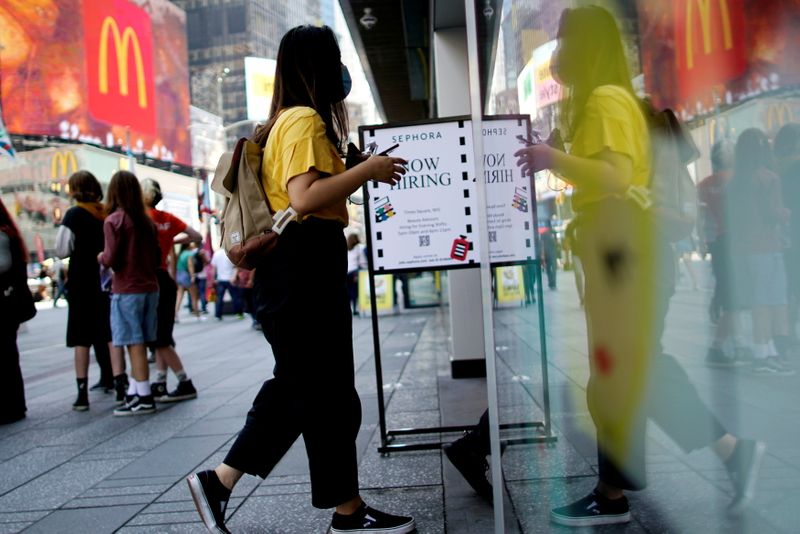© Reuters
By Noreen Burke
Investing.com — Investors will be looking closely at Friday’s U.S. jobs report to assess how much impact the Federal Reserve’s rate hikes are having on the economy. Several Fed officials are also due to speak during the week, as markets try to gauge their appetite for another 75 basis-point rate hike at the bank’s November meeting. U.S. equity markets look set to remain volatile after closing the books on their third straight quarterly decline on Friday. In the U.K. investors will be looking at the Conservative Party’s annual conference for any indications of a U-turn on the government’s tax-cutting budget which has sent sterling plummeting and government borrowing costs soaring. Meanwhile, OPEC is reported to be considering a major production cut at its upcoming meeting on Wednesday. Here’s what you need to know to start your week.
- September employment report
Friday’s jobs report for September will show whether the Fed’s aggressive series of rate hikes is having an impact on the labor market.
Economists are expecting the U.S. economy to have created jobs last month, with the unemployment rate holding steady at and staying elevated.
Recent jobs data have indicated that the labor market remains robust despite a series of jumbo-sized rate hikes.
Another strong jobs report could underline the case for even more hawkishness from the Fed, potentially roiling markets already hard hit by worries over how high rates may have to rise as the central bank battles the worst inflation in forty years.
On the other hand, indications that the labor market is slowing could add to fears that aggressive Fed tightening risks tipping the economy into a recession.
- Fedspeak
Several Fed policymakers are due to make appearances during the week, including New York Fed President John , Atlanta Fed President Raphael Bostic, Chicago Fed President Charles Evans, San Francisco Fed President Mary Daly, and Cleveland Fed President Loretta .
Investors are assessing the likelihood of another 75 basis-point at the Fed’s November meeting. Recent comments by Fed officials have indicated that they want to see clear evidence of slowing inflation before they let up on the policy tightening.
The Fed’s policy rate is now in the 3.00%-3.25% range, a full 3 percentage points higher than where it was at the start of 2022, and officials have penciled in more rate rises later this year and in 2023.
The economic calendar also includes data on August along with surveys of and sector activity from the Institute of Supply Management, which are expected to remain solid.
- Stock market volatility
Markets are entering the final leg of 2022 after closing out a tumultuous third quarter on Friday, roiled by stubbornly high inflation, rising interest rates and recession fears.
Wall Street has posted three quarterly declines in a row, the longest losing streak for the and the since 2008 and the longest quarterly slump in seven years.
As the Fed ramped up its monetary policy tightening to tame the worst inflation in decades, U.S. Treasury yields shot to their highest levels in more than a decade, slamming stock valuations.
Many investors believe the wild moves will continue until there is evidence that the Fed is winning its battle against inflation, allowing policymakers to eventually end monetary tightening.
- U.K. market turmoil
The Conservative Party’s annual conference gets underway on Sunday and market participants will be closely watching speeches by party leaders after the new government triggered a market meltdown with its Sept. 23 ‘mini-budget’ which included plans to slash taxes and pay for it with borrowing.
Within days hit record lows, and soaring government borrowing costs forced the Bank of England to intervene to stem a market rout.
The BoE’s pledge to buy $69 billion (£65 billion) of long-dated gilts has calmed markets for now, but it’s too soon to say the rout is over. The BoE is now in the position of having postponed its plan to sell bonds, resulting in monetary loosening, and at the same time tightening with interest rate hikes.
In November, it is expected to raise rates further and it has said it will stick to a plan to sell its bonds.
Investors say the government will have to work hard to restore confidence.
- OPEC meeting
The Organization of the Petroleum Exporting Countries and allies, including Russia, are to meet on Wednesday at OPEC’s headquarters in Vienna to finalize output quotas for November.
Earlier Sunday, Bloomberg reported that the group will consider , against a backdrop of falling oil prices and severe market volatility.
soared following Russia’s invasion of Ukraine in February but have since fallen back amid concerns over the impact of aggressive monetary tightening on the outlook for global growth. The stronger U.S. dollar has also weighed on prices.
-Reuters contributed to this report
Image and article originally from www.investing.com. Read the original article here.

